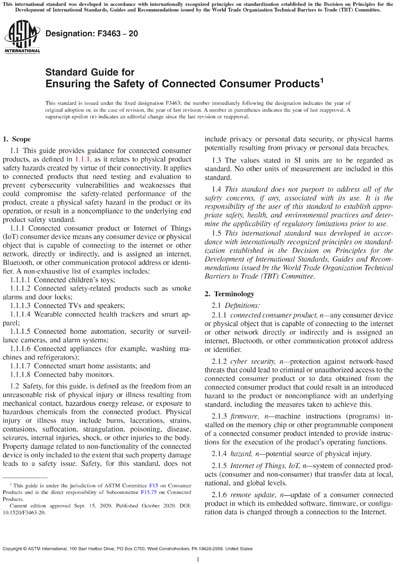Historical
ASTM F3463-20
Standard Guide for Ensuring the Safety of Connected Consumer Products
1.1 This guide provides guidance for connected consumer products, as defined in 1.1.1, as it relates to physical product safety hazards created by virtue of their connectivity. It applies to connected products that need testing and evaluation to prevent cybersecurity vulnerabilities and weaknesses that could compromise the safety-related performance of the product, create a physical safety hazard in the product or its operation, or result in a noncompliance to the underlying end product safety standard.
1.1.1 Connected consumer product or Internet of Things (IoT) consumer device means any consumer device or physical object that is capable of connecting to the internet or other network, directly or indirectly, and is assigned an internet, Bluetooth, or other communication protocol address or identifier. A non-exhaustive list of examples includes:
1.1.1.1 Connected children’s toys;
1.1.1.2 Connected safety-related products such as smoke alarms and door locks;
1.1.1.3 Connected TVs and speakers;
1.1.1.4 Wearable connected health trackers and smart apparel;
1.1.1.5 Connected home automation, security or surveillance cameras, and alarm systems;
1.1.1.6 Connected appliances (for example, washing machines and refrigerators);
1.1.1.7 Connected smart home assistants; and
1.1.1.8 Connected baby monitors.
1.2 Safety, for this guide, is defined as the freedom from an unreasonable risk of physical injury or illness resulting from mechanical contact, hazardous energy release, or exposure to hazardous chemicals from the connected product. Physical injury or illness may include burns, lacerations, strains, contusions, suffocation, strangulation, poisoning, disease, seizures, internal injuries, shock, or other injuries to the body. Property damage related to non-functionality of the connected device is only included to the extent that such property damage leads to a safety issue. Safety, for this standard, does not include privacy or personal data security, or physical harms potentially resulting from privacy or personal data breaches.
1.3 The values stated in SI units are to be regarded as standard. No other units of measurement are included in this standard.
1.4 This standard does not purport to address all of the safety concerns, if any, associated with its use. It is the responsibility of the user of this standard to establish appropriate safety, health, and environmental practices and determine the applicability of regulatory limitations prior to use.
1.5 This international standard was developed in accordance with internationally recognized principles on standardization established in the Decision on Principles for the Development of International Standards, Guides and Recommendations issued by the World Trade Organization Technical Barriers to Trade (TBT) Committee.
Content Provider
ASTM International [astm]






